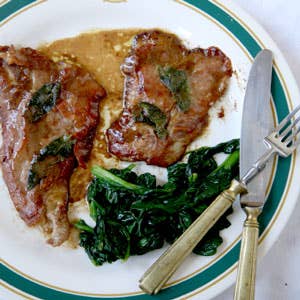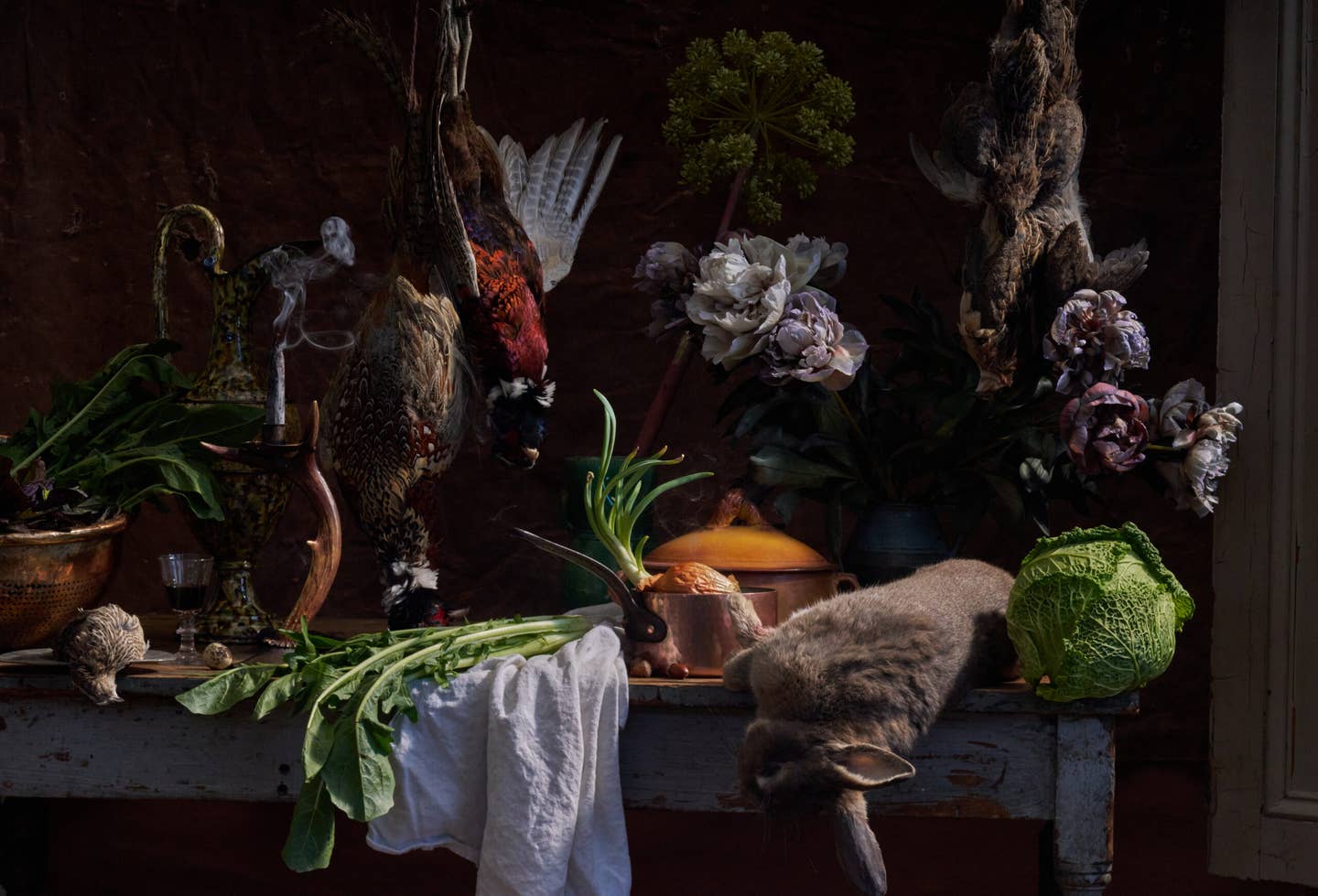
My first encounter with saltimbocca was at an old-school Italian-American restaurant my parents used to take me to in Pittsburgh during the 1970s. I remember the dish as a plump roll of breaded and fried chicken cutlets stuffed with ham and mozzarella. At the time, the dish struck me as a grown-up thing to order, but it also fell well within my comfort zone: it was effectively the same, decadent offering I'd relished in other restaurants under the aliases chicken cordon bleu and chicken kiev.
I learned later that the saltimbocca I'd loved was a very distant cousin of the elegant Roman original, an elemental composition that is at once lighter and more satisfying. In a preparation that takes only minutes to assemble and even less time to devour (saltimbocca translates literally as "jump in the mouth"), veal cutlets are pounded thin into scaloppine, topped with sage leaves, covered with thin slices of prosciutto or pancetta, sometimes dredged in flour, and pan-fried until they're crisp. Served with a simple sauce made by deglazing the pan with a slightly acidic liquid—white wine, say, or marsala—the dish achieves an overall effect that is slightly salty, slightly woodsy, and entirely sumptuous. It's no wonder that it is served in practically every trattoria in Rome.
Retracing the trajectory from saltimbocca alla romana to saltimbocca alla Pittsburgh is tricky, since the origin of the Italian dish is itself hard to pinpoint. Most sources suggest that it was born sometime in the late 19th century. One of the earliest printed recipes for it—in La scienza in cucina e l'arte di mangiar bene (The Science of Cookery and the Art of Eating Well), written by the famous gastronome Pellegrino Artusi in 1891—identifies the dish as a Roman specialty, as it is generally acknowledged to be in most parts of the world. But in the American edition of the classic cookbook Great Italian Cooking (Abradale Press, 1968), the influential chef and food writer Luigi Carnacina claimed that saltimbocca actually originated in Brescia, a city in the northern province of Lombardy. Though Carnacina (a Roman, no less) offered no proof, and despite the fact that Brescian cooks I talked to seemed surprised at the theory, other writers have perpetuated his assertion for decades. I asked the Italian food writer Roberta Corradin, a longtime resident of Rome, how Romans would respond to the suggestion that saltimbocca is Brescian. "First, they would laugh at you," she said. "And if you insisted, they would get cross."
Carnacina may have been confusing saltimbocca with the common northern Italian dish known as uccellini scappati, "little escaped birds", which consists of pieces of veal or pork threaded onto skewers along with pancetta and sage leaves. In fact, as I began to hunt for saltimbocca recipes, I found many dishes that seemed designed with the same goal in mind: to give lean, mild-tasting meat more flavor and texture by adding sage and cured pork. I also discovered numerous regional variations on traditional saltimbocca: in Sorrento, a city in the southwestern region of Campania, for example, cooks add a layer of mozzarella under the prosciutto; in other places, fish, chicken, or pork forms the foundation of the dish. While purists insist that a proper saltimbocca alla romana should be cooked and served flat, other reputable sources, including the iconic cookbook Il cucchiaio d'argento (The Silver Spoon), published in Italy in 1950, calls for rolling the saltimbocca into a tidy bundle, bringing it closer to the genre of Italian dishes called involtini, which consist of rolled meats stuffed with various ingredients, from bread crumbs to herbs. This rolled style seems to be the progenitor of the version I knew from Pittsburgh, while the flat version, after emigrating to the States, joined a battery of quick, robust sauteed dishes, like veal piccata and chicken marsala, that were staples of midcentury white-tablecloth restaurants. They endure today, even in new-breed Italian spots like Al di La, a celebrated restaurant in Brooklyn, New York, that has offered saltimbocca (a classic take, except that it's made with pork) since the restaurant opened, in 1998. "From a cook's perspective, it's a very fast pickup," explains the chef and co-owner, Anna Klinger. "I love the simplicity and the deep flavor one gets from just a few ingredients."
When I began experimenting with saltimbocca, I learned a number of interesting things. Consistently, prosciutto delivered more flavor than pancetta, which some sources cited as the dish's original adornment. Veal always yielded a fuller-tasting dish than chicken. The way the saltimbocca is built also matters: covering the outside of the cutlets with prosciutto, rather than rolling cutlets with the ham inside, produced a better texture and deeper browning, distinguished by crisp, salty ruffles of prosciutto. The flavor of the sage came through the best in recipes that called for adding the herb to the sauce, rather than layering it between the prosciutto and the veal. Some recipes call for dredging the meat in flour before pan-frying, and I can see why: the flour creates a velvety surface on the meat that browns beautifully and, when the cutlets are returned to the pan before they're served, adds richness and body to the sauce. And even though deglazing with white wine introduced a pleasant acidity, I preferred the sweeter, rounder taste of marsala.
The recipe that I ultimately picked as my favorite was based on one in SAVEUR consulting editor Lidia Bastianich's book Lidia's Italian-American Kitchen (Knopf, 2001). The recipe's only nod to innovation is its suggestion that the saltimbocca be served with spinach, a plating style common in the United States but unheard of in Rome, where contorni (side dishes) are typically served separately. Bastianich's interpretation incorporates all the best elements of the dish discussed above, along with the nifty trick of attaching the whole sage leaves with toothpicks to the outside of the prosciutto, which allows the herb to release its aromatic oils into the pan while preserving its appearance. Of course, Bastianich's is only one among many subtle adaptations of the classic saltimbocca recipe that have emerged over the years, but it's this graceful gesture that, to me, makes this version so appealing. It's a reminder that even the most enduring classics can surprise us from time to time.
Keep Reading
Continue to Next Story










